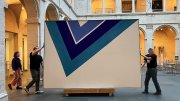Three lines, bent and blue, were painted on a creamy canvas in a day. Kenneth Noland’s 1964 abstract sensation Karma helped define “a distinctive voice in American painting” that deviated from the European standard, says Houghton curator of modern and contemporary art Mitra Abbaspour.
Noland gifted Karma to the Harvard Art Museums in 1965. But problems quickly emerged. The untreated canvas grew unevenly darker, and several irregular discolorations became more noticeable—so much so that the museum stopped displaying the painting in 2004. Conservators faced a dilemma: the technique that makes the work notable also made it difficult to refurbish.
There are two reasons Karma is hard to maintain. First, it is massive: 12 feet long and 8.5 feet tall. Second, Noland’s technique—applying a single round of synthetic paint that stained the canvas, seeped into it, and bled through the back—makes Karma materially more similar to a textile than a painting. Whereas traditional paintings (made with multiple layers of paint that lie on top of a canvas, rather than meshing with it) can be touched up with hand-rolled swabs and locally applied solutions, massive stained paintings like Karma can be harmed by such treatment.
The museum staff was befuddled until associate paintings conservator Ellen Davis presented an idea. As a graduate student at the State University of New York at Buffalo, Davis had researched a restoration technique that harnessed the power of the sun.
In September 2024, museum staffers wheeled Karma outside on a custom rig, removed it from its wooden stretcher, and laid it on a wheeled plywood board in front of the Winter Garden. For three and a half hours, as a group of students, faculty, staff, and passersby looked on, Davis sprayed the massive artwork with filtered water through a garden hose. The water pressure was strong enough to soak the water-resistant fabric, but gentle enough to prevent tearing.
Davis wheeled the painting across the lawn to follow the sun’s path, ensuring the work stayed in the shade—direct sunlight would have been too strong. She had previously participated in treatments where, relying on time in the sun alone, paintings received excessive UV light and their canvas was over-brightened, subtly shifting from warm cream to slightly cool grey.
Following its bath and suntan, Karma’s canvas is once again evenly colored and on display on the museum’s first floor. Despite years of study, Davis never learned why Noland called the piece Karma. But she has come to appreciate it, saying, “The good work that we did to take care of this—it feels like we all got a little good karma.”









